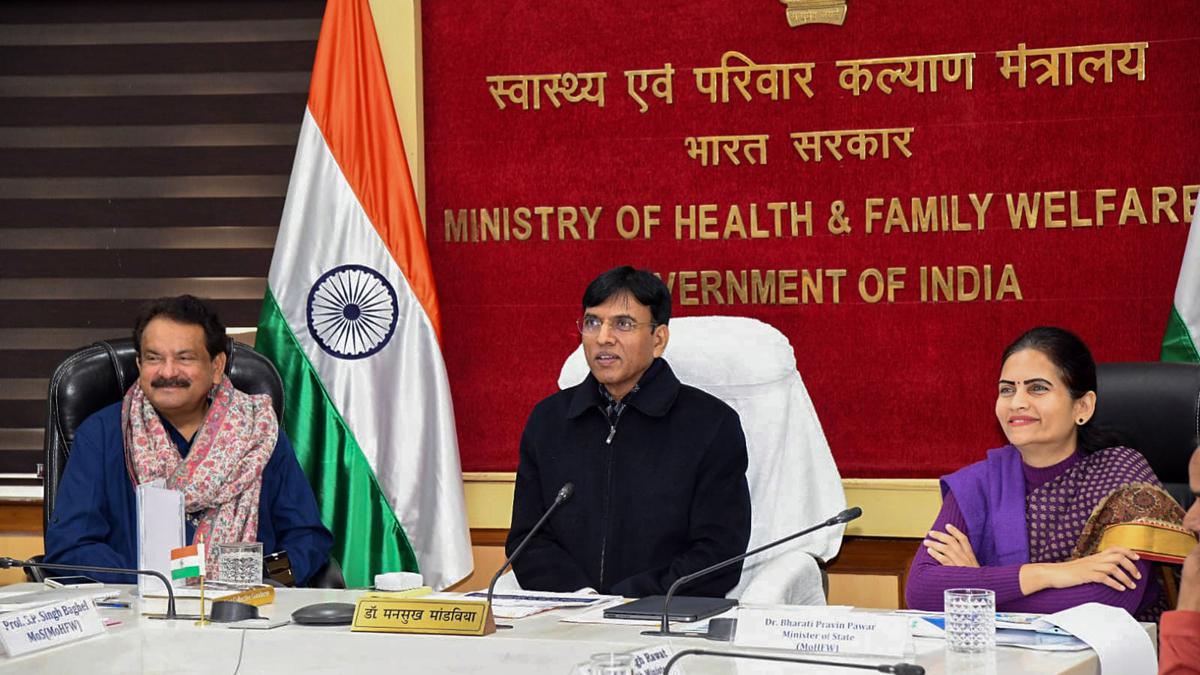According to data from the Health Ministry, 92.8% of cases in India were isolated at home, indicating mild illness; WHO classifies JN.1 as a distinct variant of interest from the parent lineage of BA.2.86.
While releasing an alert on Wednesday, the Union Health Ministry acknowledged that India has seen an increase in the daily COVID-19 positivity rate in several States, including Kerala, Maharashtra, Jharkhand, and Karnataka. However, it also stated that no clustering of cases had been reported in relation to the new JN.1 variant of the SARS-CoV-2 coronavirus.
Although the variant is presently the subject of close scientific examination, there is no reason for alarm just yet. According to the Ministry, every JN.1 case was determined to be mild, and every individual recovered without any issues.
V.K. Paul, NITI Aayog Member for Health, stated that as of right now, 21 cases of the JN.1 sub-variant have been found in India, and 91% to 92% of those with the infection are choosing to receive treatment at home. “COVID-19 sub-variant JN.1 has been linked to nineteen cases in Goa and one each in Kerala and Maharashtra. 16 COVID-19-related deaths have been reported in the last two weeks, and many of the deceased had significant comorbidities, according to Dr. Paul.
Though still smaller than in the worldwide scenario, the number of active COVID-19 cases in India has sharply increased over the past two weeks, rising from 115 on December 6 to 614 as of today. According to ministry data, 92.8% of the cases were isolated at home, indicating a mild illness.
There hasn’t been a rise in hospitalization rates linked to COVID-19. Following a virtual high-level COVID-19 review meeting with State Health Ministers, Union Health Minister Mansukh Mandaviya stated, “The cases that are hospitalized are due to other medical conditions — COVID-19 is an incidental finding.”
The World Health Organization (WHO) recently classified the variant JN.1 as a distinct variant of interest (VOI) from the parent lineage BA.2.86 due to its rapidly spreading nature. This alert from the Union Health Ministry comes shortly after. It was formerly categorized as a VOI belonging to the sub-lineages of BA.2.86.
“The additional global public health risk posed by JN.1 is currently evaluated as low based on the available evidence.” Despite this, JN.1 may raise the burden of respiratory infections in many nations as winter approaches in the Northern Hemisphere, according to the WHO.
It further stated that JN.1 and other circulating strains of SARS-CoV-2, the virus that causes COVID-19, continue to be prevented from causing serious illness and death through current vaccinations.
According to the WHO, evidence is being continuously monitored, and the JN.1 risk evaluation will be updated as necessary.
The Indian SARS-CoV-2 Genomics Consortium (INSACOG) network tracks variants through the surveillance system for whole genome sequencing of positive case samples. The Health Ministry on Wednesday ordered the system to be strengthened in order to ensure the timely detection of newer variants circulating in the nation. Dr. Mandaviya stated, “This would facilitate the undertaking of appropriate public health measures in a timely manner.”
States have been asked to increase testing, send a large number of samples of COVID-19 positive cases and illnesses resembling pneumonia to the INSACOG Genome Sequencing Laboratories every day for sequencing, and monitor the emergence of any new variants.
All States were urged by the Health Minister to stay vigilant, step up surveillance, and make sure they had enough supplies of medications, oxygen cylinders, concentrators, ventilators, and vaccines on hand. Every three months, states are required to conduct simulated exercises to evaluate the performance of PSA (pressure swing adsorption) plants, oxygen concentrators and cylinders, ventilators, and other equipment. The sharing of best practices is also encouraged.
The Ministry emphasized the difficulties brought about by the rising number of COVID-19 cases in a few nations, such as China, Brazil, Germany, and the United States, and mentioned how crucial it was to be ready for any new strains of the virus, particularly in light of the approaching holiday season.
In order to prepare suitable public health responses, the Ministry has asked States to keep an eye on newly emerging evidence of COVID-19 cases, symptoms, and case severity. This serves as a reminder that the COVID-19 issue is still ongoing.
In order to control information and reduce anxiety, states should also promote respiratory hygiene, make sure that accurate information is distributed, and combat fake news. In order to facilitate timely monitoring and prompt public health measures, states should share information in real time on cases, tests, positivity, etc., on the COVID portal, according to Dr. Mandaviya.
The number of new coronavirus infections in India has reached 614, the highest since May 21. As of Wednesday, the Union Health Ministry’s data showed 2,311 active cases. The data updated at 8 a.m. showed that the death toll was 533,321, with three deaths reported from Kerala in a span of 24 hours.
There are 45 million COVID-19 cases in the nation (45,005,978). On the website of the Health Ministry, it is stated that 44,470,346 people have recovered from the illness, and that the country’s recovery rate is 98.81%.




